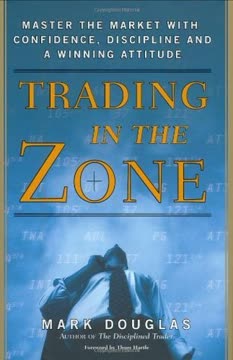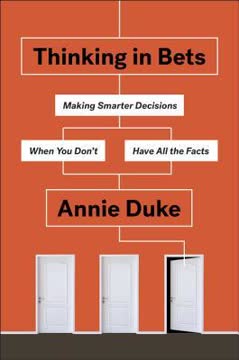Key Takeaways
1. Proprietary Trading: High-Stakes Game of Skill and Discipline
Proprietary trading firms do somewhere between 50 and 70 percent of all the equity volume on the Street on any given day.
High-stakes, high-reward environment. Proprietary trading firms, or "prop firms," are where traders use the firm's capital to make speculative trades in various financial instruments. Unlike traditional investment banks or hedge funds, prop traders don't have clients and eat what they kill – their profits come solely from their trading activities.
Key characteristics of successful prop traders:
- Disciplined risk management
- Ability to adapt to changing market conditions
- Strong pattern recognition skills
- Emotional control under pressure
- Continuous skill development and learning
The prop trading world is highly competitive, with firms often recruiting top talent from prestigious universities and athletic programs. However, academic pedigree alone doesn't guarantee success – the market demands a unique blend of analytical skills, psychological fortitude, and the ability to make split-second decisions under intense pressure.
2. One Good Trade: Focus on Process, Not Results
Do not judge a trade based upon its results! A profitable trade may or may not have been a good trade, what I call One Good Trade. A loser may have been One Good Trade.
Process over outcome. The concept of "One Good Trade" emphasizes focusing on the quality of your decision-making process rather than the immediate result of a single trade. This mindset shift is crucial for long-term success in trading.
Key elements of One Good Trade:
- Proper preparation
- Hard work
- Patience
- A detailed plan before every trade
- Discipline
- Communication
- Replaying important trades
By consistently executing trades that follow these principles, traders build a foundation for sustainable profitability. This approach helps manage the psychological challenges of trading, reducing the impact of short-term volatility on a trader's decision-making and emotional state.
3. Stocks In Play: The Foundation of Profitable Trading
You are only as good as the stocks that you trade.
Identifying opportunity. Stocks In Play are securities that offer the best trading opportunities on a given day. These stocks typically have:
- Fresh news or catalysts
- Significant price movement (up or down 3%+ pre-market)
- High volume (over 1 million shares traded)
- Potential for 3+ point intraday moves
- Real order flow and important intraday levels
Trading Stocks In Play allows traders to:
- Be more efficient with capital
- Find more excellent risk/reward opportunities
- Execute ideas with greater consistency
- Combat algorithmic trading programs
- Develop trading skills faster
By focusing on Stocks In Play, traders increase their chances of profitability and reduce time wasted on less opportune securities. This approach requires constant market awareness and the ability to quickly adapt to changing conditions throughout the trading day.
4. Reading the Tape: Essential Skill for Intraday Traders
Reading the Tape is a skill that enables the intraday trader to predict more times than not whether a stock will trade higher or lower from a given price based on just examining the bids, offers, and prints.
Decoding market dynamics. Reading the Tape is the ability to interpret real-time trading data to predict short-term price movements. This skill goes beyond traditional chart analysis, allowing traders to make split-second decisions based on order flow and market dynamics.
Key aspects of Reading the Tape:
- Identifying significant buyers and sellers
- Recognizing held bids and offers
- Spotting unusual volume patterns
- Interpreting the speed and size of trades
Developing this skill requires practice and experience, but it can provide a significant edge in intraday trading. Traders who master Reading the Tape can often anticipate price movements before they appear on charts, allowing for better entry and exit points and improved risk management.
5. Scoring: Maximize Profits Through Strategic Adjustments
Scoring, simply put, is the skill of maximizing your P&L.
Optimizing performance. Scoring involves making strategic adjustments to your trading approach to maximize profitability. This includes:
- Setting appropriate intraday loss limits
- Adjusting trading style based on time of day
- Maintaining consistency in profitable strategies
- Proper position sizing
- Developing and refining if-then statements for various scenarios
Key strategies for effective scoring:
- Focus on your best-performing setups
- Incrementally increase size on high-confidence trades
- Reduce exposure during less profitable time periods
- Continuously analyze and improve your trading statistics
By focusing on scoring, traders can turn good performance into great performance, squeezing more profit out of their successful strategies while minimizing losses on weaker trades.
6. Trader Education: Continuous Learning and Adaptation
Trading is about skill development and discipline and not understanding dark matter.
Never-ending improvement. Successful traders commit to a lifelong process of education and adaptation. This involves:
- Regular review of trading performance (e.g., video analysis)
- Staying updated on market trends and new trading technologies
- Developing mental toughness through psychology training
- Learning from mentors and peer traders
- Practicing in simulated environments before risking real capital
Effective trader education programs often include:
- Structured training curriculums
- One-on-one mentoring
- Group discussions and idea sharing
- Statistical analysis of trading performance
- Continuous feedback and performance review
The most successful traders and prop firms invest heavily in education and skill development, recognizing that the markets are constantly evolving and traders must evolve with them.
7. The Best Teacher: Mentorship Beyond Trading Prowess
Many of the great coaches were competent players in their own right, but not all-stars. They knew the game, but their passion was for teaching and developing players.
Teaching talent trumps trading talent. The best trading mentors are not necessarily the most profitable traders. Instead, they possess a unique set of skills that make them effective educators:
- Clear communication of complex concepts
- Patience with developing traders
- Ability to tailor teaching methods to individual learning styles
- Passion for trader development
- Skill in breaking down the trading process into learnable components
Characteristics of great trading mentors:
- Never satisfied with the status quo
- Highly motivated to see others succeed
- Able to build on a firm foundation of trading basics
- Looks inward for continuous self-improvement
- Practices patience while knowing when to be tough
The best trading education comes from mentors who can not only demonstrate successful trading but can effectively transfer their knowledge and experience to others. This often requires a different skill set than what makes a great individual trader.
Last updated:
FAQ
What's One Good Trade about?
- Focus on Proprietary Trading: One Good Trade by Mike Bellafiore explores the competitive world of proprietary trading, highlighting the skills and mindset needed for success.
- Lessons from Experience: The book shares insights from Bellafiore's experiences at SMB Capital, a proprietary trading firm he co-founded, detailing both triumphs and setbacks.
- Trader Development: It emphasizes the importance of trader development, discipline, and continuous improvement, serving as a guide for both novice and seasoned traders.
Why should I read One Good Trade?
- Practical Insights: The book provides practical insights into the routines and strategies of successful traders, making it a valuable resource for anyone interested in trading.
- Real-Life Examples: Bellafiore uses real-life examples and anecdotes to illustrate key trading concepts, making the lessons relatable and applicable.
- Focus on Fundamentals: It stresses the importance of mastering trading fundamentals, helping readers build a solid foundation for their trading careers.
What are the key takeaways of One Good Trade?
- One Good Trade Philosophy: Focus on making "One Good Trade" at a time, emphasizing the process over profits.
- Seven Trading Fundamentals: Traders should adhere to fundamentals like preparation, hard work, patience, planning, discipline, communication, and reviewing trades.
- Adaptability: Successful traders must adapt to market changes and refine strategies based on experience and feedback.
What is the "One Good Trade" concept in One Good Trade?
- Focus on Execution: Emphasizes executing trades based on sound fundamentals, avoiding emotional or noise-driven decisions.
- Judging Trades: Trades should be judged by adherence to the trading plan and fundamentals, not just by profit.
- Continuous Improvement: Encourages consistent, disciplined trades for long-term profitability.
What are the seven fundamentals outlined in One Good Trade?
- Proper Preparation: Thorough preparation before market opens, including stock research and trading plan development.
- Hard Work: Consistent effort and dedication to improving trading skills are crucial for success.
- Patience: Wait for optimal setups and prices, avoiding rushed trades.
How does Mike Bellafiore suggest controlling emotions while trading?
- Recognize Emotional Triggers: Keep a journal to identify emotional triggers during trading and address them.
- Visualization Techniques: Use visualization exercises to manage emotions and maintain focus, especially after losses.
- Practice Mental Resilience: Develop the skill to control emotions, recognizing trading potential and avoiding impulsive decisions.
What is the significance of "Stocks In Play" in One Good Trade?
- Definition of Stocks In Play: Stocks with fresh news, significant price movement, or high volume, ideal for intraday trading.
- Opportunity for Profit: Capitalize on volatility and liquidity, increasing chances of profitable trades.
- Focus on Execution: Concentrate on a few Stocks In Play daily to maximize trading efficiency.
How does One Good Trade address the importance of mental agility?
- Adaptability in Trading: Mental agility allows traders to adapt to market changes and make quick decisions.
- Overcoming Biases: Encourages letting go of biases and focusing on current market conditions for consistent profitability.
- Learning from Mistakes: Emphasizes learning from mistakes as opportunities for growth, with adaptability leading to success.
What is the concept of Trades2Hold in One Good Trade?
- Longer-Term Intraday Trades: Strategy of holding positions longer during intraday trading to capitalize on larger movements.
- Focus on Strong Stocks: Trade strong stocks in an uptrend, buying pullbacks and holding until the trend breaks.
- Risk Management: Effective risk management is crucial, with readiness to exit if the market turns.
How does One Good Trade define the concept of Reading the Tape?
- Understanding Market Dynamics: Interpreting market data and price movements to make informed trading decisions.
- Identifying Trends: Use tape reading to identify trends and potential reversals, aiding timely entries and exits.
- Real-Time Decision Making: Enables real-time decisions based on current conditions, crucial for intraday success.
What role does mentorship play in One Good Trade?
- Guidance and Support: Mentorship provides guidance and support, significantly impacting trader development.
- Learning from Experience: Mentors share experiences and insights, helping new traders avoid common pitfalls.
- Building Confidence: A good mentor instills confidence, encouraging risk-taking and skill development.
What are the best quotes from One Good Trade and what do they mean?
- “Do not judge a trade based upon its results!”: Emphasizes judging trade quality by adherence to the plan, not just profitability.
- “By failing to prepare, you are preparing to fail.”: Highlights the critical importance of preparation for trading success.
- “The market can remain irrational longer than you can remain solvent.”: Reminds traders to be cautious and not overextend, as markets can be unpredictable.
Review Summary
One Good Trade receives mixed reviews, with an average rating of 4.01/5. Positive reviews praise its insights into proprietary trading, trader development, and psychological aspects. Critics find it self-indulgent and lacking concrete trading strategies. Many appreciate the real-world examples and emphasis on discipline, risk management, and continuous learning. Some readers find the book's tone arrogant and the content repetitive. Overall, it's considered valuable for understanding the trading world, but not a comprehensive guide to trading techniques.
Similar Books










Download PDF
Download EPUB
.epub digital book format is ideal for reading ebooks on phones, tablets, and e-readers.





